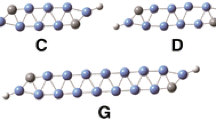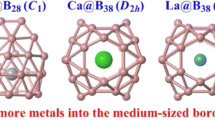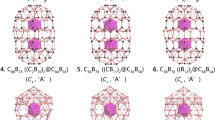Abstract
Inspired by the exciting properties of B80 clusters and the novel chemical bonding of planar tetra-coordinated carbon (ptC), we computationally investigated C12B68 clusters by substituting 12 boron atoms to 12 carbon in the B80 framework. Three types of C12B68 configurations, namely core-shell, boron-trapped and fullerene-like, were examined. The fullerene-like C12B68 clusters are featured with multiple quasi-planar tetra-coordinated carbon moieties; though with “magic” (72) number of electrons, they are not highly aromatic due to the limitations of Hirsch’s rule for clusters with more than 50 π electrons. These C12B68 fullerenes are not global minima, but the appreciable HOMO-LUMO gaps, spherical aromaticity, and the thermal stability indicate their reasonable stabilities.

Spherical C12B68 fullerenes with “magic” π-electrons and quasi-planar tetra-coordinated carbon



Similar content being viewed by others
References
Hawthorne MF (1991) Biochemical applications of boron cluster chemistry. Pure Appl Chem 63:327–334
Zhao YF, Lusk MT, Dillon AC, Heben MJ, Zhang SB (2008) Boron-based organometallic nanostructures: hydrogen storage properties and structure stability. Nano Lett 8:157–161
Wu GF, Wang JL, Zhang XY, Zhu LY (2009) Hydrogen storage on metal-coated B80 buckyballs with density functional theory. J Phys Chem C 113:7052–7057
Li M, Li YF, Zhou Z, Shen P, Chen ZF (2009) Ca-coated boron fullerenes and nanotubes as superior hydrogen storage materials. Nano Lett 9:1944–1948
Zhang CG, Zhang R, Wang ZX, Zhou Z, Zhang SB, Chen Z (2009) Ti-substituted boranes as hydrogen storage materials: a computational quest for ideal combination of stable electronic structure and optimal hydrogen uptake. Chem Eur J 15:5910–5919
Presilla-Márquez JD, Larson CW, Carrick PG (1996) Fourier transform infrared spectroscopy of the ν2 vibration of BC2 in Ar at 10 K. J Chem Phys 105:3398–3405
Presilla-Márquez JD, Carrick PG, Larson CW, Rittby CML (1999) Vibrational spectra of linear BC3 and linear B2C2 in argon at 10 K. J Chem Phys 110:5702–5709
Wang CR, Huang RB, Liu ZY, Zheng LS (1995) C n B− (n < 13): laser generation and ab initio calculations. Chem Phys Lett 242:355–360
Kimura T, Sugai T, Shinohara H (1996) Production and characterization of boron- and silicon-doped carbon clusters. Chem Phys Lett 256:269–273
Wang LM, Averkiev BB, Ramilowski JA, Huang W, Wang LS, Boldyrev AI (2010) Planar to linear structural transition in small boron-carbon mixed clusters: C x B5−x − (x = 1–5). J Am Chem Soc 132:14104–14112
Exner K, Schleyer PvR (2000) Planar hexacoordinate carbon: a viable possibility. Science 290:1937–1940
Wang ZX, Schleyer PvR (2001) Construction principles of "hyparenes": families of molecules with planar pentacoordinate carbons. Science 292:2465–2469
Minyaev RM, Gribanova TN, Starikov AG, Minkin VI (2001) Octacoordinated main-group element centres in a planar cyclic B8 environment: an ab initio study. Mendeleev Commun 11:213–214
Islas R, Heine T, Ito K, Schleyer PvR, Merino G (2007) Boron rings enclosing planar hypercoordinate group 14 elements. J Am Chem Soc 129:14767–14774
Averkiev BB, Zubarev DY, Wang LM, Huang W, Wang LS, Boldyrev AI (2008) Carbon avoids hypercoordination in CB6 -, CB6 2-, and C2B5 - planar carbon-boron clusters. J Am Chem Soc 130:9248–9250
Wang LM, Huang W, Averkiev BB, Boldyrev AI, Wang LS (2007) CB7 −: experimental and theoretical evidence against hypercoordinate planar carbon. Angew Chem Int Ed 46:4550–4553
Averkiev BB, Wang LM, Huang W, Wang LS, Boldyrev AI (2009) Experimental and theoretical investigations of CB8 −: towards rational design of hypercoordinated planar chemical species. Phys Chem Chem Phys 11:9840–9849
Pei Y, Zeng XC (2008) Probing the planar tetra-, penta-, and hexacoordinate carbon in carbon − boron mixed clusters. J Am Chem Soc 130:2580–2592
Martin JML, Taylor PR (1994) Ab initio study of the molecules BC and B2C. J Chem Phys 100:9002–9006
Zhan CG, Iwata S (1997) Ab initio studies on the structures, vertical electron detachment energies, and fragmentation energies of C n B− clusters. J Phys Chem A 101:591–596
Wang LJ, Zhang CJ, Wu HS (2005) Structure, stability and spectra of CnBδ (δ = 0, ±1; n = 1 6) clusters. Acta Phys -Chim Sin 21:244–249
Chuchev K, BelBruno JJ (2004) Density functional theory study of the isomers of C n B and CnB2. J Phys Chem A 108:5226–5233
McAnoy AM, Bowie JH, Blanksby SJ (2003) A theoretical study of C4B isomers. The interconversion of CCBCC and CCCCB via cyclic C4B. J Phys Chem A 107:10149–10153
Liu CH, Tang MS, Wang HM (2007) The conversion among various B4C clusters: a density functional theoretical study. J Phys Chem A 111:704–709
Wang R, Zhang D, Zhu R, Liu C (2007) Density functional theory study of B n C (n = 1–7) clusters. J Mol Struct THEOCHEM 817:119–123
Shao J, Zhu X, Lu X, Shi R (2008) Geometries and stabilities of (n + 4)-membered monocyclic C n B4 (n = 2–9) clusters. J Mol Struct THEOCHEM 855:82–91
Cui Z, Contreras M, Ding Y, Merino G (2011) Planar tetracoordinate carbon versus planar tetracoordinate boron: the case of CB4 and its cation. J Am Chem Soc 133:13228–13231
Liao Y, Cruz CL, Schleyer PvR, Chen Z (2012) Many M©B n boron wheels are local, but not global minima. Phys Chem Chem Phys 14:14898–14904
Bomble L, Steinmann SN, Perez-Peralta N, Merino G, Corminboeuf C (2013) Bonding analysis of planar hypercoordinate atoms via the generalized BLW-LOL. J Comput Chem 34:2242–2248
Kouvetakis J, Kaner RB, Sattler ML, Barlett N (1986) A novel graphite-like material of composition BC3, and nitrogen–carbon graphites. J Chem Soc Chem Commun 1758–1759
Way BM, Dahn JR, Tiedje T, Myrtle K, Kasrai M (1992) Preparation and characterization of B x C1−x thin films with the graphite structure. Phys Rev B 46:1697–1702
Yanagisawa H, Tanaka T, Ishida Y, Matsue M, Rokuta E, Otani S, Oshima C (2004) Phonon dispersion curves of a BC3 honeycomb epitaxial sheet. Phys Rev Lett 93:177003–177004
Tomanek D, Wentzcovitch RM, Louie SG, Cohen ML (1988) Calculation of electronic and structural properties of BC3. Phys Rev B 37:3134–3136
Luo X, Yang J, Liu H, Wu X, Wang Y, Ma Y, Wei SH, Gong X, **ang H (2011) Predicting two-dimensional boron–carbon compounds by the global optimization method. J Am Chem Soc 133:16285–16290
Wu X, Pei Y, Zeng XC (2009) B2C graphene, nanotubes, and nanoribbons. Nano Lett 9:1577–1582
Yanagisawa H, Ishida Y, Tanaka T, Ueno A, Otani S, Oshima C (2006) Metastable BC3 honeycomb epitaxial sheets on the NbB2(0001) surface. Surf Sci 600:4072–4076
Yanagisawa H, Tanaka T, Ishida Y, Matsue M, Rokuta E, Otani S, Oshima C (2005) Analysis of phonons in graphene sheets by means of HREELS measurement and ab initio calculation. Surf Interface Anal 37:133–136
Ding Y, Wang Y, Ni J, Shi L, Shi S, Li C, Tang W (2011) First-principles study of half-metallicity in semi-hydrogenated BC3, BC5, BC7, and B-doped graphone sheets. Nanoscale Res Lett 6:190–196
Popov IA, Boldyrev AI (2012) Deciphering chemical bonding in a BC3 honeycomb epitaxial sheet. J Phys Chem C 116:3147–3152
Hoffmann R, Alder RW, Wilcox JrCF (1970) Planar tetracoordinate carbon. J Am Chem Soc 92:4992–4993
Minyaev RM, Gribanova TN, Minkin VI, Starikov AG, Hoffmann R (2005) Planar and pyramidal tetracoordinate carbon in organoboron compounds. J Org Chem 70:6693–6704
Sun WX, Zhang CJ, Cao ZX (2008) Novel beltlike and tubular structures of boron and carbon clusters containing the planar tetracoordinate carbon: a theoretical study of (C3B2) n H4 (n = 2–6) and (C3B2) n (n = 4–8). J Phys Chem C 112:351–357
Zhang CJ, Sun WX, Cao ZX (2008) Zigzag boron − carbon nanotubes with quasi-planar tetracoordinate carbons. J Am Chem Soc 130:5638–5639
Szwacki NG, Sadrzadeh A, Yakobson BI (2007) B80 fullerene: an ab initio prediction of geometry, stability, and electronic structure. Phys Rev Lett 98:166804–4
Szwacki NG, Sadrzadeh A, Yakobson BI (2008) Erratum: B80 fullerene: An ab initio prediction of geometry, stability, and electronic structure. Phys Rev Lett 100:159901–1
Galeev TR, Chen Q, Guo J, Bai H, Miao C, Lu H, Sergeeva AP, Li S, Boldyrev AI (2011) Deciphering the mystery of hexagon holes in an all-boron graphene α-sheet. Phys Chem Chem Phys 13:11575–11578
Penev ES, Bhowmick S, Sadrzadeh A, Yakobson BI (2012) Polymorphism of two-dimensional boron. Nano Lett 12:2441–2445
Wu X, Dai J, Zhao Y, Zhuo Z, Yang J, Zeng XC (2012) Two-dimensional boron monolayer sheets. ACS Nano 6:7443–7453
Yu X, Li L, Xu X, Tang C (2012) Prediction of two-dimensional boron sheets by particle swarm optimization algorithm. J Phys Chem C 116:20075–20079
Pochet P, Genovese L, De S, Goedecker S, Caliste D, Ghasemi SA, Bao K, Deutsch T (2011) Low-energy boron fullerenes: role of disorder and potential synthesis pathways. Phys Rev B 83:081403(R)−4
Hayami W, Otani S (2011) Structural stability of boron clusters with octahedral and tetrahedral symmetries. J Phys Chem A 115:8204–8207
Muya JT, Sato T, Nguyen MT, Ceulemans A (2012) Pseudo-Jahn–Teller origin of icosahedral instability in boron buckyball, B80. Chem Phys Lett 543:111–116
Muya JT, Ramanantoanina H, Daul C, Nguyen MT, Gopakumar G, Ceulemans A (2013) Jahn–Teller instability in cationic boron and carbon buckyballs B80 + and C60 +: a comparative study. Phys Chem Chem Phys 15:2829–2835
Zope RR, Baruah T (2009) Dipole polarizability of isovalent carbon and boron cages and fullerenes. Phys Rev B 80:033410–033414
Botti S, Castro A, Lathiotakis NL, Andrade X, Marques MAL (2009) Optical and magnetic properties of boron fullerenes. Phys Chem Chem Phys 11:4523–4527
Muya JT, Proft FD, Geerlings P, Nguyen MT, Ceulemans A (2011) Theoretical study on the regioselectivity of the B80 buckyball in electrophilic and nucleophilic reactions using DFT-based reactivity indices. J Phys Chem A 115:9069–9080
Anafcheh M, Ghafouri R (2012) Density functional investigation of the electronic properties of B80 fullerene exposed to regioselective chemisorption of nucleophiles NH3, PH3 and AsH3. Superlattices Microstruct 52:861–871
Sadrzadeh A, Pupysheva OV, Singh AK, Yakobson BI (2008) The boron buckyball and its precursors: an electronic structure study. J Phys Chem A 112:13679–13683
Li H, Shao N, Shang B, Yuan L, Yang J, Zeng XC (2010) Icosahedral B12-containing core–shell structures of B80. Chem Commun 46:3878–3880
De S, Willand A, Amsler M, Pochet P, Genovese L, Goedecher S (2011) Energy landscape of fullerene materials: a comparison of boron to boron nitride and carbon. Phys Rev Lett 106:225502–225504
Li F, ** P, Jiang D, Zhang SB, Zhao JJ, Chen Z (2012) B80 And B101−103 clusters: remarkable stability of the core-shell structures established by validated density functionals. J Chem Phys 136:074302–074308
Hirsch A, Chen Z, Jiao H (2000) Spherical aromaticity in I h symmetrical fullerenes: The 2(N + 1)2 rule. Angew Chem Int Ed 39:3915–3917
Reiher M, Hirsch A (2003) From rare gas atoms to fullerenes: spherical aromaticity studied from the point of view of atomic structure theory. Chem Euro J 9:5442–5452
Bühl M, Hirsch A (2001) Spherical aromaticity of fullerenes. Chem Rev 101:1153–1183
Chen Z, King RB (2005) Spherical aromaticity: recent work on fullerenes, polyhedral boranes, and related structures. Chem Rev 105:3613–3642
Chen Z, Wu JI, Corminboeuf C, Bohmann J, Lu X, Hirsch A, PvR S (2012) Is C60 buckminsterfullerene aromatic? Phys Chem Chem Phys 14:14886–14891
Bühl M (2000) NMR properties of polylithiated C60. Z Anorg Allg Chem 626:332–337
Perdew JP, Burke K, Ernzerhof M (1996) Generalized gradient approximation made simple. Phys Rev Lett 77:3865–3868
Frisch MJ et al. (2009) Gaussian 09, Revision A.01. Gaussian Inc, Wallingford.
Tao J, Perdew JP, Staroverov VN, Scuseria GE (2003) Climbing the density functional ladder: nonempirical meta–generalized gradient approximation designed for molecules and solids. Phys Rev Lett 91:146401–146404
Delley B (1990) An all-electron numerical method for solving the local density functional for polyatomic molecules. J Chem Phys 92:508–517
Delley B (2000) From molecules to solids with the DMol3 approach. J Chem Phys 113:7756–7764
Laaksonen L (1992) A graphics program for the analysis and display of molecular dynamics trajectories. J Mol Graph 10:33–34
Bergman DL, Laaksonen L, Laaksonen A (1997) Visualization of solvation structures in liquid mixtures. J Mol Graph Model 15:301–306
Schleyer PvR, Maerker C, Dransfeld A, Jiao H, NvE H (1996) Nucleus-independent chemical shifts (NICS): A simple and efficient aromaticity probe. J Am Chem Soc 118:6317–6318
Chen Z, Wannere C, Corminboeuf C, Puchta R, Schleyer PvR (2005) Nucleus-independent chemical shifts (NICS) as an aromaticity criterion. Chem Rev 105:3842–3888
Schleyer PvR, Subramanian G, Dransfeld A (1996) Decisive evidence for nonclassical bonding in five-vertex closo-boranes, X2B3H3, X = N, CH, P, SiH, BH−. J Am Chem Soc 118:9988–9989
Schleyer PvR, Subramanian G, Jiao H, Najafian K, Hofmann M (1997) In: Siebert W (ed) Advances in boron chemistry. The Royal Society of Chemistry, Cambridge, pp 3–14
Schleyer PvR, Najafian K, Mebel A (1998) The large closo-borane dianions, B n H n 2− (n = 13–17) are aromatic, why are they unknown? Inorg Chem 37:6765–6772
Schleyer PvR, Najafian K (1998) In: Casanova J (ed) The borane, carborane and carbocation continuum. Wiley, New York, pp 169–190
Schleyer PvR, Najafian K (1998) Stability and three-dimensional aromaticity of closo-monocarborane anions, CB n−1H n − and Closo-dicarboranes, C2B n−2H n . Inorg Chem 37:3454–3470
Najafian K, Schleyer PvR, Tidwell TT (2003) Stability and three-dimensional aromaticity of closo-NB n−1H n azaboranes, n = 5–12. Inorg Chem 42:4190–4203
Wang ZX, Schleyer PvR (2003) A "Sea Urchin" family of boranes and carboranes: the 6 m + 2n electron rule. J Am Chem Soc 125:10484–10485
Martyna GJ, Klein ML, Tuckerman ME (1992) Nosé–Hoover chains: the canonical ensemble via continuous dynamics. J Chem Phys 97:2635–2643
Jiang D, Walter M, Dai S (2010) Gold sulfide nanoclusters: a unique core-in-cage structure. Chem Euro J 16:4999–5003
Prasad DLVK, Jemmis ED (2010) Stuffed fullerenelike boron carbide nanoclusters. Appl Phys Lett 96:023108–3
Wade K (1971) The structural significance of the number of skeletal bonding electron-pairs in carboranes, the higher boranes and borane anions, and various transition-metal carbonyl cluster compounds. J Chem Soc D Chem Commun 15:792–793
Chen Z, Neukermans S, Wang X, Janssens E, Zhou Z, Silverans RE, King RB, PvR S, Lievens P (2006) To achieve stable spherical clusters: general principles and experimental confirmations. J Am Chem Soc 128:12829–12834
Jemmis ED, Balakrishnarajan MM, Pancharatna PD (2002) Electronic requirements for macropolyhedral boranes. Chem Rev 102:93–144
Acknowledgments
This work was supported by the National Science Foundation Grants EPS-1010094 and DoD Grant W911NF-12-1-0083. Work at ORNL (DFT-based basin-hop** search) was supported by the U.S. Department of Energy, Office of Science, Basic Energy Sciences, Chemical Sciences, Geosciences, and Biosciences Division; this research used resources of the National Energy Research Scientific Computing Center (NERSC), which is supported by the Office of Science of the U.S. Department of Energy under contract no. DE-AC02-05CH11231.
Author information
Authors and Affiliations
Corresponding author
Additional information
This paper belongs to a Topical Collection on the occasion of Prof. Tim Clark’s 65th birthday
Electronic supplementary material
Below is the link to the electronic supplementary material.
Supplementary materials available
The molecular orbitals of C12B68 III-(C i , 6.89 eV), B80 (2, T h ), and the Cartesian coordinates of the lowest-energy C12B68 structures of core-shell, boron-trapped and fullerene-like patterns, the basin-hop** searched structures, the most stable C6B74 fullerene based on B80 volleyball, as well as the full citation of ref. [69] are available as supplementary materials. (PDF 3759 kb)
Rights and permissions
About this article
Cite this article
Li, F., Jiang, De. & Chen, Z. Computational quest for spherical C12B68 fullerenes with “magic” π-electrons and quasi-planar tetra-coordinated carbon. J Mol Model 20, 2085 (2014). https://doi.org/10.1007/s00894-014-2085-z
Received:
Accepted:
Published:
DOI: https://doi.org/10.1007/s00894-014-2085-z




